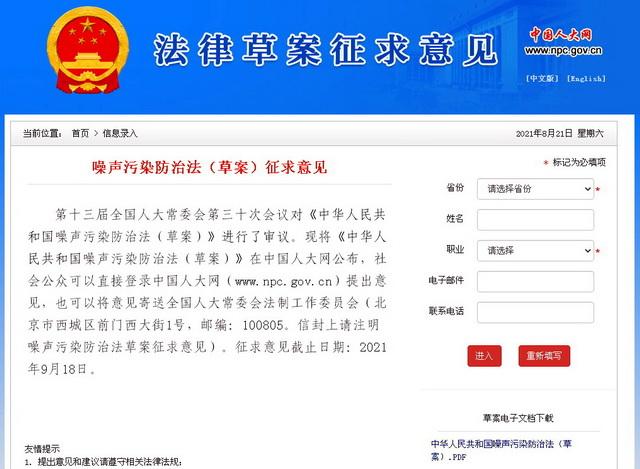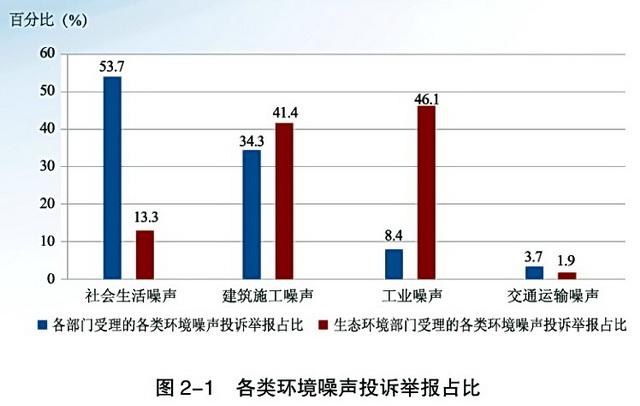
31 Years of Focus
Noise Control Integrated Service Provider


News
News Center
Draft Noise Pollution Prevention Law Opens for Public Comment; Prevention Measures to Be Included in Performance Evaluations
Author:
Source:
First Finance | Published: 08-21 09:51
Release date:
2021-09-08 15:40
(Summary description)The draft Noise Pollution Prevention and Control Law is now open for public comment starting today, August 21, with the consultation period ending on September 18. The draft has already been published on the website of the National People's Congress of China. In March of this year, "strengthening the control of environmental noise pollution" was included for the first time in both the 14th Five-Year Plan and the Visionary Goals Outline for 2035. The Ministry of Ecology and Environment has explicitly stated that this year it will collaborate closely on revising the Noise Pollution Prevention and Control Law, enhancing comprehensive planning, source control, categorized management, collaborative governance involving society, and accountability for environmental damage. Additionally, the ministry will initiate preliminary research for a Noise Pollution Prevention Action Plan and a noise-target assessment system, while also piloting assessments of acoustic environment functional zoning.
The draft Noise Pollution Prevention and Control Law is now open for public comment starting today, August 21, with the consultation period ending on September 18. The draft has been published on the website of the National People's Congress of China.
This March, the goal of "strengthening environmental noise pollution control" was included for the first time in both the 14th Five-Year Plan and the Visionary Goals Outline for 2035. The Ministry of Ecology and Environment has clarified that this year it will collaborate on revising the Noise Pollution Prevention and Control Law, while also enhancing comprehensive planning, source control, categorized management, collaborative governance involving society, and accountability for environmental damage. Additionally, the ministry will initiate preliminary research for a Noise Pollution Prevention Action Plan and a noise-target assessment system, and will pilot assessments of acoustic environment functional zoning.
The draft Law on Noise Pollution Prevention and Control proposes that noise pollution control should adhere to the principles of integrated planning, source-based prevention, categorized management, collaborative governance by society, and accountability for damages. When governments at all levels implement environmental protection target responsibility systems and assessment mechanisms, they must include the achievement of noise pollution control objectives as part of these evaluations.
Experts involved in the revision of the Noise Pollution Prevention and Control Law stated that everyone has experienced various forms of noise pollution at some point—and everyone desires "peaceful silence." Addressing noise pollution requires collective effort from all of us. Among the three key approaches—source control during planning, noise reduction along transmission paths, and protective measures for affected individuals—source control during the planning phase is the most critical.


According to incomplete statistics released by the Ministry of Ecology and Environment, in 2020, departments including ecological environment, public security, housing, and urban-rural construction across China’s county-level cities under provincial jurisdiction and cities at or above the prefecture level collectively received approximately 2.018 million environmental noise-related complaints and reports. Among these, complaints about social life noise accounted for the largest share at 53.7%, followed by construction site noise at 34.2%, industrial noise at 8.4%, and transportation noise at 3.7%.
In 2020, the "National Platform for Managing Ecological and Environmental Complaints, Petitions, and Reports" received over 441,000 public reports. Among these, noise pollution complaints accounted for 41.2% of all reports, ranking second among various environmental pollution concerns (with odors topping the list of environmental complaints).
According to the "2021 China Environmental Noise Pollution Prevention and Control Report" released by the Ministry of Ecology and Environment in June of this year, in 2020, the overall daytime compliance rate for urban functional area acoustic environments across the country reached 94.6%, while the nighttime compliance rate was 80.1%. These figures represent increases of 2.2 and 5.7 percentage points, respectively, compared to the previous year, indicating an overall improvement in urban acoustic environmental quality. Daytime road traffic noise levels remained largely stable compared to the previous year. However, nighttime compliance rates continued to lag behind in rehabilitation and sanatorium areas, regions along major roadways, and residential and educational zones.
In March 2020, the Fourth Session of the 13th National People's Congress adopted the "Resolution on the Work Report of the Standing Committee of the National People's Congress," which included the amendment of the Law on Noise Pollution Control in the NPC's 2021 Legislative Work Plan.
Keywords:
Prevention and control of noise pollution, public announcement
Next page

